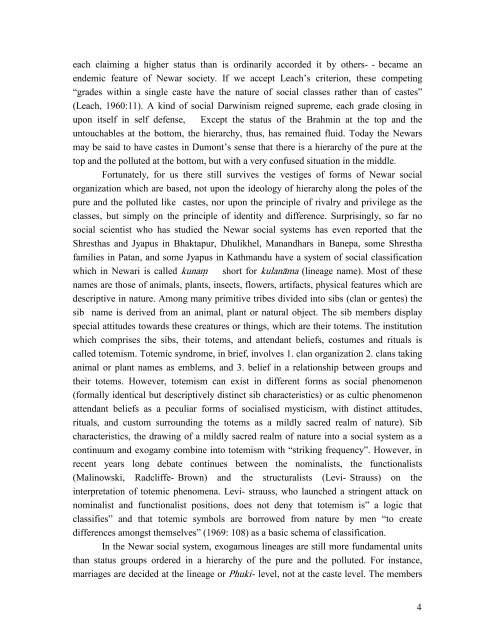Download >> Vestiges of Totemism in Newar Society - Dr. Kamal P ...
Download >> Vestiges of Totemism in Newar Society - Dr. Kamal P ...
Download >> Vestiges of Totemism in Newar Society - Dr. Kamal P ...
Create successful ePaper yourself
Turn your PDF publications into a flip-book with our unique Google optimized e-Paper software.
each claim<strong>in</strong>g a higher status than is ord<strong>in</strong>arily accorded it by others--became an<br />
endemic feature <strong>of</strong> <strong>Newar</strong> society. If we accept Leach’s criterion, these compet<strong>in</strong>g<br />
“grades with<strong>in</strong> a s<strong>in</strong>gle caste have the nature <strong>of</strong> social classes rather than <strong>of</strong> castes”<br />
(Leach, 1960:11). A k<strong>in</strong>d <strong>of</strong> social Darw<strong>in</strong>ism reigned supreme, each grade clos<strong>in</strong>g <strong>in</strong><br />
upon itself <strong>in</strong> self defense, Except the status <strong>of</strong> the Brahm<strong>in</strong> at the top and the<br />
untouchables at the bottom, the hierarchy, thus, has rema<strong>in</strong>ed fluid. Today the <strong>Newar</strong>s<br />
may be said to have castes <strong>in</strong> Dumont’s sense that there is a hierarchy <strong>of</strong> the pure at the<br />
top and the polluted at the bottom, but with a very confused situation <strong>in</strong> the middle.<br />
Fortunately, for us there still survives the vestiges <strong>of</strong> forms <strong>of</strong> <strong>Newar</strong> social<br />
organization which are based, not upon the ideology <strong>of</strong> hierarchy along the poles <strong>of</strong> the<br />
pure and the polluted like castes, nor upon the pr<strong>in</strong>ciple <strong>of</strong> rivalry and privilege as the<br />
classes, but simply on the pr<strong>in</strong>ciple <strong>of</strong> identity and difference. Surpris<strong>in</strong>gly, so far no<br />
social scientist who has studied the <strong>Newar</strong> social systems has even reported that the<br />
Shresthas and Jyapus <strong>in</strong> Bhaktapur, Dhulikhel, Manandhars <strong>in</strong> Banepa, some Shrestha<br />
families <strong>in</strong> Patan, and some Jyapus <strong>in</strong> Kathmandu have a system <strong>of</strong> social classification<br />
which <strong>in</strong> <strong>Newar</strong>i is called kuna^ short for kulan@ma (l<strong>in</strong>eage name). Most <strong>of</strong> these<br />
names are those <strong>of</strong> animals, plants, <strong>in</strong>sects, flowers, artifacts, physical features which are<br />
descriptive <strong>in</strong> nature. Among many primitive tribes divided <strong>in</strong>to sibs (clan or gentes) the<br />
sib name is derived from an animal, plant or natural object. The sib members display<br />
special attitudes towards these creatures or th<strong>in</strong>gs, which are their totems. The <strong>in</strong>stitution<br />
which comprises the sibs, their totems, and attendant beliefs, costumes and rituals is<br />
called totemism. Totemic syndrome, <strong>in</strong> brief, <strong>in</strong>volves 1. clan organization 2. clans tak<strong>in</strong>g<br />
animal or plant names as emblems, and 3. belief <strong>in</strong> a relationship between groups and<br />
their totems. However, totemism can exist <strong>in</strong> different forms as social phenomenon<br />
(formally identical but descriptively dist<strong>in</strong>ct sib characteristics) or as cultic phenomenon<br />
attendant beliefs as a peculiar forms <strong>of</strong> socialised mysticism, with dist<strong>in</strong>ct attitudes,<br />
rituals, and custom surround<strong>in</strong>g the totems as a mildly sacred realm <strong>of</strong> nature). Sib<br />
characteristics, the draw<strong>in</strong>g <strong>of</strong> a mildly sacred realm <strong>of</strong> nature <strong>in</strong>to a social system as a<br />
cont<strong>in</strong>uum and exogamy comb<strong>in</strong>e <strong>in</strong>to totemism with “strik<strong>in</strong>g frequency”. However, <strong>in</strong><br />
recent years long debate cont<strong>in</strong>ues between the nom<strong>in</strong>alists, the functionalists<br />
(Mal<strong>in</strong>owski, Radcliffe-Brown) and the structuralists (Levi-Strauss) on the<br />
<strong>in</strong>terpretation <strong>of</strong> totemic phenomena. Levi-strauss, who launched a str<strong>in</strong>gent attack on<br />
nom<strong>in</strong>alist and functionalist positions, does not deny that totemism is” a logic that<br />
classifies” and that totemic symbols are borrowed from nature by men “to create<br />
differences amongst themselves” (1969: 108) as a basic schema <strong>of</strong> classification.<br />
In the <strong>Newar</strong> social system, exogamous l<strong>in</strong>eages are still more fundamental units<br />
than status groups ordered <strong>in</strong> a hierarchy <strong>of</strong> the pure and the polluted. For <strong>in</strong>stance,<br />
marriages are decided at the l<strong>in</strong>eage or Phuki-level, not at the caste level. The members<br />
4


